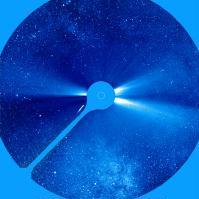The one who gave the sun to the moon

According to experts, the planets found in the solar system were formed at the same time as the sun itself. But instead of turning all matter into a great star, he created the sun we know and some planets revolving around. These planets, including our Earth, receive with the emission of the sun a powerful bombardment of particles. This escape is called the solar wind. It should be noted that during these days the Stardust probe of NASA has suffered the biggest solar wind storm of the last twenty years.
Strange Chemistry
When the solar system arose, the solar wind was stronger. It is seen in the chemical composition of the current planets. Carbon, helium or neon, on the Moon, are remnants of the solar wind. In the case of nitrogen, however, the arrival of the sun is not enough to explain the results of the analyses. The type of nitrogen in the solar wind is not the same as the surface of the moon.
Another contribution to consider in the study of the chemical composition comes from meteorites. On the Moon, as on other planets, many meteorites fall. The collision produces the heating of the soil and the evaporation of some atoms (helium, neon, etc. ). Nitrogen, on the contrary, generates relations with other elements of the soil, so it does not suffer alterations in these processes. Therefore, it is necessary to search for new sources of this element.
An article published in the journal Science offers many possibilities. One of these sources can be the nitrogen of the fallen meteorites. Another option is the nitrogen emerged from the interior of the moon. Perhaps, since nitrogen is the most abundant component of the earth's atmosphere, it can be passed from the upper layers to the moon.
The only thing that scientists are clear is that the nitrogen of the moon has two types of origin, the solar wind and the other side. The second type of nitrogen is produced on the surface of the cloud grains, so the proportion is higher in the large surface specimens.
Finally, we must not forget that nowadays the activity of the solar wind has not disappeared and that at present the type of nitrogen that means this escape is not equal to the initial one. The composition of the initial one greatly influenced the formation of the atmosphere of Jupiter, so scientists consider the large planet as a model in this type of analysis.
The goal of a NASA mission (Genesis Mission) to be launched in the near future is solar research. It replaces, therefore, the finished mission SOHO. Many data were collected in this mission, but the current technology allows for more accurate analysis. In this genesis, samples of solar wind will be collected to, among other things, perform analysis of the type of nitrogen. According to experts, these data are essential to begin to unravel the mystery of the chemical composition of the moon.
Buletina
Bidali zure helbide elektronikoa eta jaso asteroko buletina zure sarrera-ontzian











